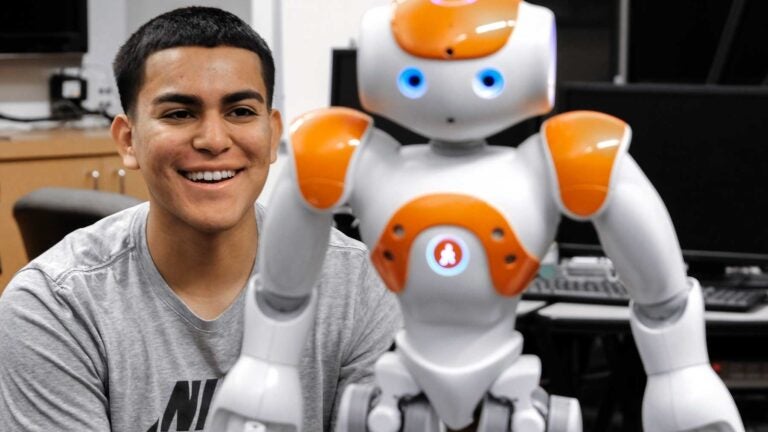
Omar Silva, 17, works in the robotics lab with the SHINE program at USC Viterbi. (USC Photo/Gus Ruelas)
Aspiring engineers take on robotics, biotech and aerospace in USC Viterbi labs
Exceptional high school students spend their summers studying challenging fields of research with PhD students and faculty
[new_royalslider id=”185″]
For Jacqueline Ayestas, biomedical engineering is personal. She’s spending much of the summer in lab gear, investigating new drug therapies alongside PhD students and faculty in USC Viterbi School of Engineering laboratories.
“My sister was diagnosed with brain cancer when I was 10,” said Ayestas, a senior at Harvard Westlake High School. “She’s always been my best friend, and that inspired an interest in cancer research. I’m very social, so I wasn’t sure research was for me. But I enjoy being in a biomedical lab, and I realize this is something I may want to do.”
Ayestas is one of 26 high school students immersed in engineering research as part of USC Viterbi’s Summer High School Intensive in Next-Generation Engineering (SHINE) program, now in its third year. Students spend up to 40 hours each week conducting research in engineering fields including biotech, robotics, aerospace and cybersecurity.
“It’s transformational,” said Katie Mills, manager of USC Viterbi’s K-12 STEM outreach program called Viterbi Adopt-a-School, Adopt-a-Teacher. “Students come in liking physics or math or engineering, and yet their lab experience is never what they think it’s going to be. They always tell us it’s more amazing than they imagined.”
Surrounded by other high-achieving students in an academic research setting, students become researchers under the mentorship of graduate students.
The students help each other transform because they’re not stuck in the identity that’s been locked in at their high school.
Katie Mills
“The students help each other transform because they’re not stuck in the identity that’s been locked in at their high school,” Mills said. “The kind of student who comes here wants to go to a top engineering school.”
When coding becomes cool
Omar Silva, a student from Garfield High School in East Los Angeles, is working on a robotics project that contributes to research on developing smarter prosthetic limbs. Those limbs would feature sensors that feel and process tactile information.
“At first I wasn’t sure what went into a moving prosthetic arm,” said Silva, who’s attending SHINE on a full scholarship from the TELACU Education Foundation. “It’s a lot of math, a lot of coding. I never thought coding was cool until I saw this.”
The program involves students in all steps of the process of scientific communication, from performing literature reviews to presenting research results in a poster session. Some students tackle environmental engineering challenges like climate change, food waste and energy sustainability. Biotech students work to engineer miniature human tissues known as “organs on chips,” which can be used to study disease and test new drug therapies.
SHINE students are found in a variety of labs, including materials science, electrical engineering, industrial and systems engineering, and civil engineering.
New career pathways
SHINE has helped some students realize the importance of research in medicine. Ray Zhang, a senior at Oak Park High School, said his goal of becoming a doctor is shifting now that he has been involved in cancer research.
I wanted to become a doctor so I could help people, but I wasn’t thinking about research.
Ray Zhang
“I wanted to become a doctor so I could help people, but I wasn’t thinking about research,” Zhang said. “Now I see it differently. In research, you’re looking forward, looking for solutions medicine doesn’t yet have.”
Ayestas is focused on oncology, but the program has opened her eyes to the possibilities of biomedical research.
“When my sister went through surgery and chemotherapy, I got to see different parts of the hospital where people were caring and loving,” she said. “I saw the bond they had with patients, with everyone they were treating. That was special. I hope to have that kind of impact.”
